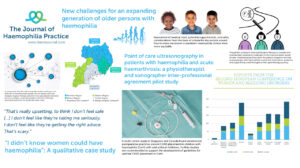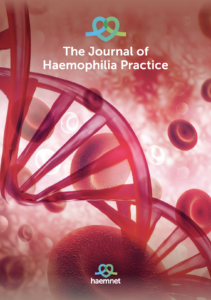A good year for The Journal of Haemophilia Practice
 There is always a sense of anticipation among Haemnet’s publications team when we receive the annual report for The Journal of Haemophilia Practice. As every year, the first thing to happen when the 2022 report arrived was a quick scroll through to find the statistics on readership and article downloads.
There is always a sense of anticipation among Haemnet’s publications team when we receive the annual report for The Journal of Haemophilia Practice. As every year, the first thing to happen when the 2022 report arrived was a quick scroll through to find the statistics on readership and article downloads.
With over 25,800 unique clicks on content and articles downloaded almost 24,000 times, 2022 was the journal’s best year yet.
Broad horizons and inclusivity
The treatment landscape and the journal have both grown in the years since its launch. Our most popular article last year (based on number of downloads) discusses shared decision-making in the context of gene therapy for haemophilia. The subject matter throughout the 2022 issue builds on this, with papers on the patient pathway in haemophilia gene therapy, the ageing haemophilia population, and the use of discrete choice experiments in patient preference studies, among others.
The journal’s international reach has grown too, with authors from less well-resourced settings in India and Uganda sharing their knowledge and experience alongside those from well-resourced countries including Canada and Singapore. There are also reports rooted in systems change from the EHC Think Tank, and from the Second European Conference on Women and Bleeding Disorders.
The ethos on which The Journal of Haemophilia Practice was founded remains the same, though, and is based on the belief that all specialists and experts in bleeding disorders and their care can contribute to understanding of this rare disease area. That means nurses, physiotherapists, psychologists, social workers, data managers, and all allied health professionals specialised in bleeding disorders care. It means patient experts too. And it means supporting research based on practices relevant to the lived experiences of bleeding disorders care in different parts of the world.
Ten years on
 In its tenth anniversary year, the new volume of The Journal of Haemophilia Practice has a refreshed look. We’ve opened with an update from the EHC Think Tank and papers focusing on joint health assessment in Northeast India, the intergenerational impact of the Contaminated Blood Scandal, and how Japanese parents approach discussing haemophilia with their daughters. We’re also pleased to publish the first articles in a series where specialist bleeding disorder nurses discuss how experiences with patients influence their practice – and we’re looking forward to publishing more in this series throughout the year.
In its tenth anniversary year, the new volume of The Journal of Haemophilia Practice has a refreshed look. We’ve opened with an update from the EHC Think Tank and papers focusing on joint health assessment in Northeast India, the intergenerational impact of the Contaminated Blood Scandal, and how Japanese parents approach discussing haemophilia with their daughters. We’re also pleased to publish the first articles in a series where specialist bleeding disorder nurses discuss how experiences with patients influence their practice – and we’re looking forward to publishing more in this series throughout the year.
“We established the journal to help nurses and other members of the multidisciplinary team to publish case studies, qualitative research and more,” says Kate Khair, the journal’s Editor-in-Chief. “I’m delighted that we are still doing that with a broader reach across health care professionals and affected individuals. This journal really is for everyone involved in haemophilia (self) care and practice – and I look forward to seeing more from you all soon.”
The current and previous issues of The Journal of Haemophilia Practice are open access and available online.
For more information about The Journal of Haemophilia Practice or Haemnet’s publishing activities, email us at publishing@haemnet.com
About the author
Kathryn Jenner is Editorial Director at Haemnet. Email kathryn@haemnet.com

Scan the QR Code to follow us on Social Media
